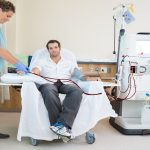(HealthDay News) — Taking care of a significant wound helps prevent infection and minimize scaring, the Nemours Foundation says. The foundation suggests how to care for a wound at home: Keep the wound covered with a clean dressing until it stops producing fluid. Wait an average of four days after surgery before showering. Ask your doctor for a specific time to wait. Do not soak in the bathtub or swim until your next doctor visit. Don’t let pets get close to a wound. Do not pick or scratch a scab.
A little about: Weekly Gravy
All Sauce from Weekly Gravy:
How Color Can Help You De-Stress

Many studies have shown that color affects both mood and behavior. Color can help you go from sad to happy or angry to calm. When it comes to mood, there are four primary colors. Though different shades within each of the four can have different effects, some generalities exist. Red symbolizes power and strength and may even stimulate aggression. Yellow is associated with joy, hope and optimism. As “warm” colors, both red and yellow are thought to increase arousal. Green is emotionally calming and stands for harmony. Blue is the color of intellect, yet is so calming that it can lower blood pressure. As “cool” shades, both blue and green can be relaxing. Much research has found that people living in areas with more green space have better physical and mental health than those with less green space. A European study looked at the effects on city dwellers of making purposeful visits to green spaces in four cities. They found strong positive links, including better mental health and more vitality. For another study, Michigan State University researchers analyzed data from the other side of the world. They compared the effects of living with a view of the ocean or of green space on residents of Wellington, New Zealand. They found that just looking out on a pure blue ocean or sea can significantly improve distress.… read on >
Poor Sleep Plagues Many Kids With Autism

Young children with autism are more than twice as likely to have sleep problems than typical kids or those with other developmental delays, a new study reports. Several factors profoundly affect the sleep of 2- to 5-year-olds with autism spectrum disorder (ASD), said lead researcher Dr. Ann Reynolds. They are more likely to resist their bedtime, have trouble getting to sleep, suffer from anxiety regarding sleep, wake up in the middle of the night, and experience night terrors. “It was very clear that kids with features of autism have more sleep issues,” said Reynolds, an associate professor of developmental pediatrics at the University of Colorado School of Medicine in Aurora. “For almost all categories, there was a difference between ASD kids and the general population.” It was already known that kids with autism struggle with sleep. Studies have consistently found that more than half of them and possibly as many as 4 in 5 have at least one chronic sleep problem, according to Autism Speaks. Reynolds and her team decided to delve deeper into the issue, to see which sleep problems appeared to be more affected by the symptoms of autism. They also wanted to compare kids with ASD to average children and to those who have other disorders that cause developmental delay. Researchers recruited almost 2,000 children between the ages of 2 and 5… read on >
How to Decide When You’re Too Sick to Work

Even if you think you can go to work when you have a cold or flu, you need to think about others, an infectious disease expert says. “I see a lot of patients whose jobs and stress make them feel torn between staying home and going in when they’re sick,” said Dr. Robin Wigmore. She is a primary care physician and infectious disease specialist at Beth Israel Deaconess Medical Center in Boston. “But viral infections like the common cold and flu are contagious. It’s important to consider your co-workers’ health as well,” Wigmore said in a medical center news release. To make an informed decision, first consider how long you’ve been feeling ill. “You are most contagious in the first 48 hours of a viral illness,” Wigmore explained. “This is often even before you begin feeling symptoms.” This means you should stay home at the first sign of symptoms. That will avoid spreading your illness and allow you to rest, stay hydrated and take care of yourself. Ask yourself if your symptoms are contagious. Viruses can be passed through the air by coughing or sneezing, and some cold and flu germs can survive on surfaces such as countertops, doorknobs and phones for up to 24 hours. “As a general rule, if you have a wet cough, a runny nose, fevers or aches, you should probably… read on >
Developing Self-Compassion: How to Show Yourself Some Love

A lot of importance is placed on developing self-esteem to create emotional well-being and to quiet the inner critic that causes people to doubt themselves. But even more essential to emotional wellness might be self-compassion — extending to yourself the same feelings of empathy and concern that you show others. Self-compassion leads to contentment and offers a kind of immunity against negative influences like fear, according to researcher Kristin Neff, associate professor of educational psychology at the University of Texas at Austin. More than self-esteem, self-compassion can soothe you when you’re upset, help you gain perspective, and allow you to accept your faults. With that mindset, you can flourish. Neff has identified three important elements of self-compassion: Self-kindness: This simply means being understanding with yourself, rather than judgmental. Feeling connected with others in life: This is what Neff calls “common humanity.” Mindfulness: This is often described as viewing a situation in real time without coloring it with “what ifs?” Self-compassion doesn’t depend on your reaching ideal and possibly unrealistic goals, but from caring for yourself as you are, with your own balance of weak and strong points. People with self-compassion experience less anxiety and are more comfortable in their own skin. What’s more, if you’re a mom or dad, having self-compassion can help you feel more at ease with your parenting skills, which will benefit… read on >
Get The Most From Frozen Vegetables

When it comes to cooking veggies, fresh from the farmer’s market always tastes best. But when you’re cooking produce out of season, head to the freezer section of your favorite store. Veggies are typically frozen at the height of freshness, making them a great winter staple. Dense vegetables in particular are ideal for freezer storage, because they retain their texture when reheated. Put peas, edamame, Brussels sprouts and artichokes at the top of your list. As long as you don’t overcook them, they’ll also retain their nutrients. Microwaving can dry out some vegetables. To defrost them quickly, place them in a colander under cold running water for a few minutes. Then add them to green salads or fold into any cooked dish. One of the easiest ways to use frozen vegetables is to add them straight from the freezer to soups, stews and chilis during the last few minutes of cooking. Frozen vegetables also are great in breakfast smoothies: Simply blend frozen edamame — a protein powerhouse — along with your fruits and yogurt. Frozen artichokes are far less expensive than fresh, plus all the prep work has been done for you. Here’s a simple recipe that’s both a crowd pleaser and a great alternative to bottled dressings when you want a dip for carrot sticks. Artichoke Dip 1/2 cup frozen artichokes, defrosted 1/2 cup… read on >
CPR Not Always Given at Dialysis Clinics When Needed

When kidney failure patients undergoing treatment at dialysis clinics suffer cardiac arrest, the clinic staff usually jumps in to perform lifesaving CPR, but not always, a new study finds. “It is reassuring that bystander CPR was associated with improved outcomes in dialysis clinics just as it is in other settings, but it is concerning that the rate of dialysis staff-initiated CPR isn’t closer to 100 percent, considering that all staff should be CPR-trained,” said study author Dr. Patrick Pun, from Duke University, in Durham, N.C. More research is needed to determine why this is so, the study authors said in a news release from the American Society of Nephrology. For the study, Pun’s team examined the cases of 398 kidney failure patients who suffered cardiac arrest at outpatient dialysis clinics in the southeastern United States between 2010 and 2016. The study did not include patients with “do not resuscitate” orders. Before emergency medical services arrived, dialysis clinic staff started CPR in 81 percent of the cases and used defibrillators in 52 percent of the cases, the findings showed. Clinic staff-initiated CPR was associated with a three times higher chance of survival and a favorable brain result when a patient left the hospital. There was no association between staff defibrillator use and patient outcomes, according to the report. Staff were more likely to start CPR if… read on >
Does Social Media Push Teens to Depression? New Study Says No

Time spent on Instagram, Snapchat or Facebook probably isn’t driving teenagers to depression, a new study contends. In fact, Canadian researchers found the relationship worked in the opposite direction — teenage girls who were already depressed tended to spend more time on social media, to try to feel better. These findings run counter to a series of recent studies that said teens and young adults were more likely to grow depressed if they used social media more often. But those studies only looked at adolescents’ depression and social media use at one point in time, taking a single survey “snapshot” that couldn’t assess which factor influences the other, explained Pamela Rutledge, director of the Media Psychology Research Center in Santa Barbara, Calif. The new study looked at people over time and tried to make sense of their behaviors over time, said Rutledge, who was not involved in the research. “To me it makes a lot of sense, because we also know that social media can have a lot of benefits,” she said. “With anything, there is positive and negative. Social media is this great big thing, and there are all sorts of ways to use it.” Beginning in 2017, researchers led by Taylor Heffer from Brock University in St. Catharines, Ontario, surveyed nearly 600 sixth-, seventh- and eighth-graders in Ontario once a year for two… read on >
Cutting Calories Can Boost Your Sex Life and Your Sleep

The benefits of eating fewer calories may go far beyond losing weight. Three decades of animal studies have found that eating fewer calories can extend lifespan and reduce the risk of chronic diseases and even some cancers. And some, though not all, of these benefits are starting to be seen in men and women taking part in clinical trials. For instance, in moderately overweight people, restricting calories by 25 percent over two years improved blood pressure and cholesterol counts, and resulted in weight loss. Participants also had a 47 percent drop in levels of C-reactive protein, a marker of inflammation linked to heart disease. A second study done by researchers from the same institutions focused on calorie restriction to see if it affected other important aspects of life like mood, sleep and sex. Not surprisingly, the participants who ate 25 percent fewer calories lost weight — about 15 pounds on average. What was surprising? Their mood significantly improved, and they experienced more vigor, less tension and better overall health. They also had an improved sex drive, better relationships and even greater sleep quality. Keep in mind that safe calorie restriction means reducing intake without depriving yourself of essential nutrients. So every calorie has to be carefully chosen. This is especially important if you’re already at a healthy weight without any fat stores to burn. Make… read on >
Global Rate of Suicide Deaths Is on the Decline

There’s bad news and good news in a study of lives lost to suicide around the world. In sheer numbers, more of the world’s people are dying by suicide each year than ever before, the new report reveals. In 2016, about 817,000 deaths worldwide were attributed to suicide, the study showed. That’s an increase from the 762,000 suicides calculated for 1990. However, after the researchers adjusted their numbers for changes in age and population size, they found that the suicide fatality rate actually decreased by nearly a third between 1990 and 2016. Only further study can determine whether the decline is due to better suicide prevention efforts or to general improvements in population health, the researchers said. The analysis of data from the 2016 Global Burden of Disease Study also found that the worldwide rate of suicide death was higher among men (15.6 deaths per 100,000) than women (7 deaths per 100,000). However, that wasn’t true for most countries with what the researchers called a “low sociodemographic index” — a measure of fertility, income and education. In those nations, women had higher suicide rates than men, according to the study published Feb. 6 in the BMJ. The researchers were led by Mohsen Naghavi, a professor of health metrics at the University of Washington in Seattle. He and his colleagues said the wide variations in suicide… read on >









